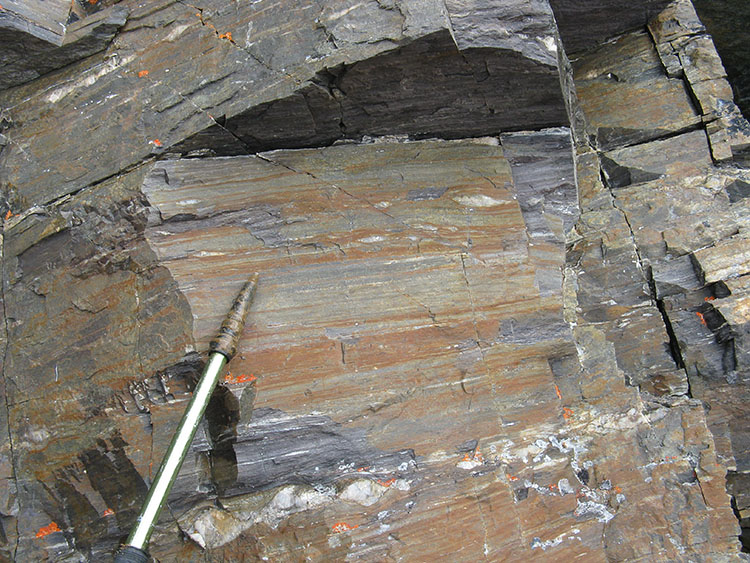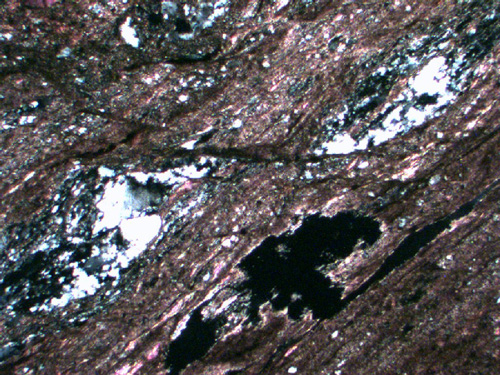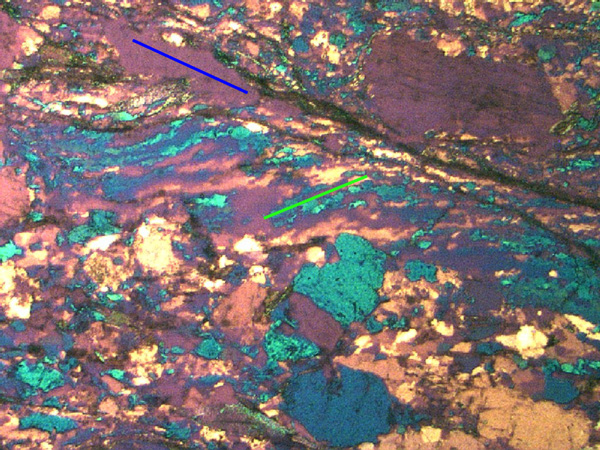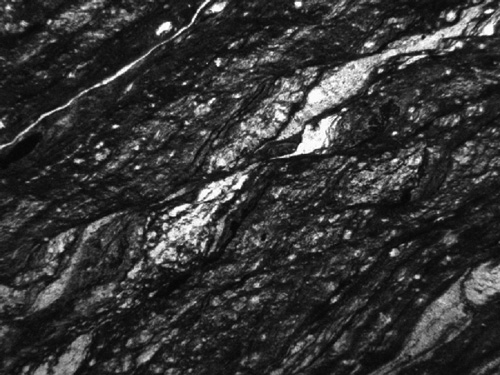Ductile shear zones and crustal
strength profiles
Lecture index: Larger
context and significance of ductile shear zones. / Ductile
fault rocks. / Composite
fabrics in originally homogeneous rock. / Composite fabrics in originally
layered/ foliated rocks. / Porphyroclasts
and other related sense of shear indicators. / Crustal
strength profiles and thin-skinned tectonics.
Readings:
- Chapter 15 - Fossen, Structural Geology
- Simpson, C., 1986, Determination of Movement
Sense In Mylonites; Journal of Geological Education, v. , p.
246-259.
Terms:
- Sibson's classification
- mylonites
- ultramylonites
- blastomylonites
- L-tectonite
- S-tectonite
- phyllonites
- composite surfaces
- S and C surfaces
- DSF and NSC and RSC
- augen
- asymmetric porphyroclasts and sense of shear
- mica fish
- inclusion swirls
- Alleghanian southern Appalachian dextral
shear zones
- normal ductile detachments in the Himalayas
Larger context and significance of ductile shear zones
 The
San Andreas plate boundary must extend through lithosphere, circa
100 km. The seismogenic (earthquake producing) zone is the upper
20 km or so. Therefore below 15 km ductile processes must be accommodating
fault movement. The same is true of other plate boundary related
faults. It is this realm of 'ductile faulting' that we are focusing on
in this lecture.
The
San Andreas plate boundary must extend through lithosphere, circa
100 km. The seismogenic (earthquake producing) zone is the upper
20 km or so. Therefore below 15 km ductile processes must be accommodating
fault movement. The same is true of other plate boundary related
faults. It is this realm of 'ductile faulting' that we are focusing on
in this lecture.
The image to the right is a block diagram
of the portion of the San Andreas fault system near Los Angeles,
and depicts the brittle to ductile transition. Note by the way
the presence of thrust faults as part of the deformation system.
We will discuss this later. Image source: http://pubs.usgs.gov/fs/1999/fs110-99/
.
Understanding ductile fault zone kinematics
has allowed us to understand the large scale behavior of mountain
belts better. One can argue that it has been responsible for the
recognition of gravitational collapse of orogenic welts as a
tectonic process.
Ductile shear zones can also be major zones
of intraplate brittle fault reactivation later in their history (e.g. Billefjorden fault
zone in Spitsbergen has Devonian, Carboniferous and Tertiary brittle reactivation of a Caledonian
mylonite zone). This may be because of the presence
of a well developed fabric, and their continuity.
A ductile shear zone rock classification is
reviewed in your readings. If you check out various text books
or publications there is some dispute as to the classification
and exact definitions of different ductile fault rock types. It
is typically depicted that the fault zone width increases with
depth as one passes through the transition from brittle to ductile.
This has implications for fault rock classification. One common
scheme identifies likely fault rock types on the basis of depth
in the crust. Cataclasites are where brittle processes
dominate at a hand specimen scale. Breccias and gouges are types
of cataclasites. Below that one gets into the realm of ductile
fault rocks.
Factors that influence ductile fault rock character?
- rock type
- strain rate
- pressure and temperature conditions
- fluid flow
- kinematics
- strain weakening and feedback loops between above - e.g. feldspar to muscovite transition
Ductile fault rocks
mylonite: initially there was fruitful debate on what characterizes
a mylonite. The following is one summary of the outcomes from that
debate.
- a ductilely deformed rock with a notable
simple shear component (i.e. a definition based on genesis).
- may also include pure shear component, and
volume loss component (although not required).
- typically notable grain size reduction from
'parent' rock due to dynamic recrystallization.
- some appear as flinty rocks or 'quartzites'
in the field. Typically have a well developed fabric.
- strong preferred orientation of crystallographic
axes is very typical.
- otherwise remarkably variable.
 Image of a mylonitic gneiss associated
with the San Andreas fault described in a USGS
site. Note the very well formed fabric formed by the elongation
of mineral aggregates. In this case the rock was initially a granitoid
plutonic rock, and the strain has produced a strong lineation.
This then would be an example of an L-tectonite (see below). Photo
by J.C. Matti, USGS, June, 1980.
Image of a mylonitic gneiss associated
with the San Andreas fault described in a USGS
site. Note the very well formed fabric formed by the elongation
of mineral aggregates. In this case the rock was initially a granitoid
plutonic rock, and the strain has produced a strong lineation.
This then would be an example of an L-tectonite (see below). Photo
by J.C. Matti, USGS, June, 1980.
 Simple map showing the relationship
between radon release and mylonite. Clearly, there seems to be
some relationship between mylonite development and indoor radon
values. Can you think of why that might be? Source of image -
USGS site
on radon in sheared rocks.
Simple map showing the relationship
between radon release and mylonite. Clearly, there seems to be
some relationship between mylonite development and indoor radon
values. Can you think of why that might be? Source of image -
USGS site
on radon in sheared rocks.
 This is a highly sheared Carboniferous
gypsum layer in a normal fault-monocline structure up in Spitsbergen.
It could be considered a gypsum mylonite. The rocks are unmetamorphosed,
and were well within what would be considered the brittle crustal
regime when deformation was occurring. However, even at these
conditions gypsum deforms ductilely, and indeed the presence of
gypsum has very much influenced the tectonic style of the area.
This is a highly sheared Carboniferous
gypsum layer in a normal fault-monocline structure up in Spitsbergen.
It could be considered a gypsum mylonite. The rocks are unmetamorphosed,
and were well within what would be considered the brittle crustal
regime when deformation was occurring. However, even at these
conditions gypsum deforms ductilely, and indeed the presence of
gypsum has very much influenced the tectonic style of the area.
Two end member types of mylonites are ultramylonites and
blastomylonites.
ultramylonite
- these are characterized by extreme grain size reduction so that
they are very fine grained. They can appear flinty. There is a
debate as to relative roles of cataclastic milling and dynamic
recrystallization, and so they are often characterized by mixed
brittle-ductile processes. Common to have inclusions (porphyroclasts).
Such mylonites can result either from very high strain rates,
or form at the brittle-ductile portion of the crust were thermal
recovery processes are not efficient.

This is slide of part of
the Goat Rock Fault zone in the Appalachian hinterland in Georgia.
The fine grain size (camera lens cap for scale) indicates this
is an ultramylonite. Originally it was coarse-grained migmatitic
gneiss, and so it has suffered a severe grain size reduction of
probably two magnitudes. The small pinkish grains that look like
phenocrysts are feldspar porphyroclasts. Such rocks have been
mistaken for phenocrystic volcanics! Note the well developed foliation.
The sense of movement on this fault zone is dextral, and it moved
during the Alleghanian orogenic episode.

This is a fine-grained mylonite (tending toward an ultramylonite) in basement rocks of NW Spitsbergen. It comes from a several hundred meter thick ductile detachment that is thought to be part of a Late Silurian to Devonian metamorphic core complex. Note the well developed lineation on the mylonitic foliation that can be seen on the overhang surface in shadow. The white lenses are deformed and boudined quartz veins. A close look will show some of the quartz lenses to have an asymmetric geometry, consistent with a foliation parallel simple shear component of deformation. In thin section biotite and garnet suggest these rocks attained lower amphibolite metamorphic grade. The grain size is much finer than typical for rocks at this metamorphic grade because of the grain reduction by ductile shear.

This another photo from the same several hundred meter thick mylonite zone as above. The cross section view is basically parallel to the lineation and transport direction. Here the asymmetric geometry and sense of shear associated with the deformed quartz veins is clearly developed (sinistral). Note the asymmetric bondinage of the quartz vein that continues to the left of the tip of the mechanical pencil.

This is another mylonite with a slightly more mica rich composition from the same mylonite zone. One question is why all the quartz veins?

This is a marble from within the same ductile fault zone as above. Since marble is typically a weaker rock it has likely suffered even greater strain than the enclosing dark mylonites shown above. Calcite recovers and recrystallizes so easily it often doesn't show the same textures as typical mylonites, but in this one more competent inclusions, the well developed foliation and the intrafolial folds all help document the very high levels of strain. A term that can be used for this rock is marble tectonite.

Here one is looking at the foliation surface of the same highly strained marble unit as depicted above. A well developed lineation can be seen, which results from the elongation of the individual calcite crystals, and likely reflects elongation in the direction of shear in the mylonite zone.
blastomylonite
- These are often coarser grained, recrystallized into a sugary
appearance, often without a strong fabric evident to the eye.
Thermal recovery, static recrystallization produced a late stage
or subsequent increase in grain size, and so these are considered
more typical of rocks deforming at deeper levels in the ductile
portion of the crust. Context or other structures indicate it
is a mylonite.


Both images are mylonites from a large complex shear zone in the Caledonian basement rocks of NW Spitsbergen. In both cases the images are 3.3 mm across in horizontal view, and under cross nichols. The left image is a blastomylonite, where thermally aided dynamic recrystallization (and possible post deformation static recrystallization) allowed the grain size to remain relatively coarse. Note the quartz grains are relatively free of undulose extinctions, indicating the dislocations have easily migrated to form grain boundaries. One can see some evidence that feldspar is recrystallizing. The right image is thought to be the same initial rock, but comes from the top of the shear zone under lower-T conditions, where dynamic grain size reduction through recrystallization has formed an ultramylonite with distributed and discrete dextral slip surfaces. Note the offset of the recrytallized quartz-feldspar aggregate. Micas dominate the deformation behavior of this ultramylonite, and the fine-grained sericite (white mica) likely formed from the breakdown and retrograde metamorphism of feldspar. Since sericite deforms much more easily than feldspar, this process greatly weakens the rock, concentrating the deformation into these rocks. This phenomena is common in large scale crustal shear zones associated with crustal extension.
foliated cataclasites - these are fault rocks truly in between brittle and ductile, and consist of angular fragments in a finer grained foliated matrix. Brittle communition of grains creates the fine-grained matrix. Grain boundary sliding, grain rolling, and pressure solution then allow for very distributed deformation in the matrix that gives it the ductile-like foliated character. Foliated cataclasites often occur in associated with ultramylonites.

Black and white thin section image (plain light, 3.3 mm horizontal field) of a foliated cataclasite found in association with ultramylonite from Spitsbergen depicted above. The hanging-wall rocks for the cataclasite are Devonian sediments and so the cataclasite formation must involve Devonian fault movement. Many of the clasts in the matrix are mylonites and ultramylonites, indicating a local progression from ductile to brittle deformation in the shear zone.
L- tectonite
- highly deformed rock with a strong linear fabric.
S- tectonite
- highly deformed rock with a strong planar fabric.
mylonites can be L or S tectonites, or a L-S
tectonite.
phyllonites:
these are rocks dominated mechanically by micas.
- micaceous rock with a notable simple shear
component.
- often not as much notable grain size reduction
because micas can grow and recrystallize relatively easily.
- highly strained inclusions or veins can give
them away.
- often have distinctive composite fabrics that indicate the simple shear component (see below).
Composite fabrics in
originally homogeneous rock
Intrusives often intrude along ductile shear
zones, and then become deformed by continued movement. This has
some interesting mechanical implications, including melt lubrication
(where the weak magmatic material decreases the fault strength
and localizes strain). Because of the ability to date intrusives,
especially granites, they also provide constraints on the timing
of deformation. In such deformed granites, 2 surfaces, one more
penetrative and the other more spaced, are often seen spatially
associated with each other. The old interpretation was that of
a later crenulation being imposed on an earlier flow fabric; i.e.
two different deformation episodes. It is now realized they form
synchronously as a result of ductile shear.
S - surface
- defined by preferred orientation of micas
+ other inequant minerals.
- more penetrative!!
- defined by long axes of deformed grains or
clasts.
- inclined to shear zone walls (consistent
with shear sense).
- thought to represent the flattening plane
of the finite strain ellipse during simple shear.
- they bend into C - surfaces.
C - surface
- spaced zones of finer-grained material, micro
shears (offsets can be seen).
- sub-parallel to shear zone walls (?).
- thought to represent discrete planes of concentrated
simple shear.

Schematic diagram of S and C surface development in a dextral ductile shear zone, along with accompanying asymmetric porphyroclasts. In reality, the C surfaces tend to anastomose some (split and join).
 Photomicrograph of mylonitic quartzofeldspathic
rock with the blue line showing a discrete C-zone and the green
line showing the orientation of S-surface in recrystallized quartz.
The sense of shear here is dextral.
Photomicrograph of mylonitic quartzofeldspathic
rock with the blue line showing a discrete C-zone and the green
line showing the orientation of S-surface in recrystallized quartz.
The sense of shear here is dextral.
Sense of motion given by S - C geometry. C-S
intersection assumed to be perpendicular to movement.
S-surface tracking across the mylonite zone
and net movement (Naruk , in metamorphic core complex):
- If have simple shear then the shear zone wall - S-surface angle function
of simple shear strain.
- Incrementally add across the ductile shear
zone.
- Naruk's example have independent answer with
dikes and seems to work.
- But, what role does C play then?
Composite fabrics in originally layered/ foliated rocks
Critical factor - original orientation of DSF
- dominant slip foliation, usually penetrative. This is
an pre-existing surface that is utilized as a slip surface. Can
develop in a separate episode of deformation, or early in a protracted
episode.
NSC - normal
slip crenulations, these are spaced and are not parallel to the
shear zone walls.
Operation of DSF as a slip plane will cause
shear zone thickening and they will rotate out of a favorable
slip position. NSC is compensating structure; allows slip planes
to keep operating. Important point is that there are two slip
systems operating.
RSC - reverse
slip crenulations are usually spaced, or isolated fold structures.
In this case DSF is oriented clockwise from slip plane in dextral
slip and the operation of DSF will cause shear zone thinning.
RSC are then the compensating thickening structure. These are
much more uncommon than NSC.
Naturally can get evolution of shear zone as
S surfaces get formed, rotated, and utilized as slip planes.

This view is of a phyllonite in the Irmo
Shear Zone, exposed on the Clarks Hill Reservoir on the South
Carolina side that shows well developed composite surfaces.. This
is part of a system of Late Alleghanian dextral shear zones that
pervade the Piedmont region. Some of the NSC are ornamented with
yellow dots, while examples of DSF are ornamented with green dots.
The shear zone walls are well defined here and approximately bisect
the acute angle between NSC and DSF.

This is a thin section of an ultramylonite from Caledonian basement rocks in NW Spitsbergen. It is under plain light and the horizontal field of view is 3.3 mm, and in black and white (there wasn't much color in the color version). In this view the DSF is running diagonally and the NSC is running more horizontal, and the sense of shear is dextral. Note the very fine grain size. The dark coloration is due to a combination of very fine-grained biotite and biotite, and the protolith of this sheared rock was an amphibolites grade, biotite gneiss/schist.
Porphyroclasts and other related sense of shear indicators
From petrology you are familiar with the term
porphyroblast - a mineral of greater grain size because it grew
larger. A porphyroclast is a grain that is greater in grain size
because deformation reduced the grain size of the surrounding
material. Porphyroclasts are usually formed by competent minerals,
that strain less. The most common type of porphyroclast is feldspar,
and the classic feldspar 'augen' (eye in german) in gneisses are
a common example. Garnets can also form good porphyroclasts.
- deformation tails on augen, asymmetric
porphyroclasts, formed by a) pressure shadow effect, b) flowage
of recrystallized marginal material.
- rotated metamorphic porphyroblast - inclusion
swirls
- sigmoidal veins.
- mica fish.
- certain fold geometries, e.g. sheath folds.


Left image: This is thin section image (crossed nichols w gypsum plate, 3.3 mm horizontal dimension) from an ultramylonite in Caledonian basement rocks in NW Svalbard. The large grain at extinction is a garnet porphyroclast. Note how the garnet is behaving brittlely, both extending with some quartz infill, and with a sinistral offset along a surface at a high angle to the mylonite foliation. Overall the sense of shear is dextral, and the porphyroclast offset can be thought of as due to antithetic slip. The age of deformation is unclear, but could be Silurian or Devonian. Right image: This is a thin section image of another specimen from nearby the one described above, and is a good example of an asymmetric porphyroclast, in this case with a sinistral sense of shear in this view direction. Note how the irregular margins of the garnet. retrograde metamorphism is changing the garnet into sericite, and that mica material is being deformed into porphyroclast tails (also known as pressure shadows. It almost like a wake area that is created as the surrounding material flows by with the sinistral sense of shear.

This is a thin section from a sheared amphibolite
from the Piedmont of Georgia, showing a feldspar porphyroclast
with an asymmetric shape (outlined in blue) and an adjacent NSC
surface that has possibly separated the two feldspar grains. The photo is under plain light, and the brown flaky
material is biotite, while the green material is hornblende.
 This is an asymmetric muscovite
porphyroclast in a thin section of the Goat Rock Fault Zone mylonite
in the Georgia Piedmont. Because of their shape these are referred
to as mica fish, and their asymmetry indicates the sense of shear.
In this image the simple shear is dextral, as it is for the GRFZ
in general. The image is under crossed nichols, and the field of
view is about .36 mm across.
This is an asymmetric muscovite
porphyroclast in a thin section of the Goat Rock Fault Zone mylonite
in the Georgia Piedmont. Because of their shape these are referred
to as mica fish, and their asymmetry indicates the sense of shear.
In this image the simple shear is dextral, as it is for the GRFZ
in general. The image is under crossed nichols, and the field of
view is about .36 mm across.
Utilization of this new understanding has led
to new understanding of large scale mechanics of mountain belts by informing us about their internal dynamics.
- e.g. Alleghanian dextral shear zones in Appalachian
crystalline hinterland, and the idea of large scale decoupling.
- e.g. recognition of normal faults in Himalayas
and the idea of gravitational collapse.
Crustal strength profiles and thin-skinned tectonics
Remember from the general positive slope of
the Mohr failure envelope that the amount of deviatoric stress
needed for brittle failure increases with depth, and so in the
brittle realm of the crust, the rocks get stronger. Indeed, the
larger earthquakes nucleate from the brittle-ductile transition,
and in many diagrams this is where the crust has its maximum strength.
Below that crustal rocks are weaker because they are hotter, and
distributed ductile strain dominates.
Link to diagram
that shows simplified upper crustal strength profile - source
of diagram USGS
site on geothermal energy.
However, consider the crust as it is, extremely
heterogeneous, and includes material and surfaces of greatly varying
strength. What features may cause significant departures from
a simple strength profile?
- low strength evaporite or shale horizons,
vs. high brittle strength sandstone or limestone horizons
- zones of over pressurization (increasing pore
pressure, and reducing brittle strength)
- basement-sediment cover contact
- intrusion zones (melt lubrication)
- brittle-ductile transition
- older detachment zones
- metamorphic fronts (and associated mineralogic
changes)
Many of these have an initially sub-horizontal
orientation The crust can then be considered to be mechanically
laminated, and it is then no surprise that it delaminates along
detachments. This produces a phenomena known as thin-skinned tectonics.
 Cross section showing thin-skinned
character of deformation associated with the Appalachian mountains.
In a thin-skinned style sub-horizontal detachments dominate, and
the rocks at different levels are deforming in very different
ways. In other words one level is detached from the other. The
autochthonous basement rocks referred to here are basically undeformed,
while a stack of thrust sheets exists above. From USGS site http://3dparks.wr.usgs.gov/nyc/images/fig37.jpg
.
Cross section showing thin-skinned
character of deformation associated with the Appalachian mountains.
In a thin-skinned style sub-horizontal detachments dominate, and
the rocks at different levels are deforming in very different
ways. In other words one level is detached from the other. The
autochthonous basement rocks referred to here are basically undeformed,
while a stack of thrust sheets exists above. From USGS site http://3dparks.wr.usgs.gov/nyc/images/fig37.jpg
.
Copyright Harmon D. Maher Jr., This may be
used for non-profit educational purposes as long as proper attribution
is given. Otherwise, please contact me. Thank you.
 The
San Andreas plate boundary must extend through lithosphere, circa
100 km. The seismogenic (earthquake producing) zone is the upper
20 km or so. Therefore below 15 km ductile processes must be accommodating
fault movement. The same is true of other plate boundary related
faults. It is this realm of 'ductile faulting' that we are focusing on
in this lecture.
The
San Andreas plate boundary must extend through lithosphere, circa
100 km. The seismogenic (earthquake producing) zone is the upper
20 km or so. Therefore below 15 km ductile processes must be accommodating
fault movement. The same is true of other plate boundary related
faults. It is this realm of 'ductile faulting' that we are focusing on
in this lecture. 



















